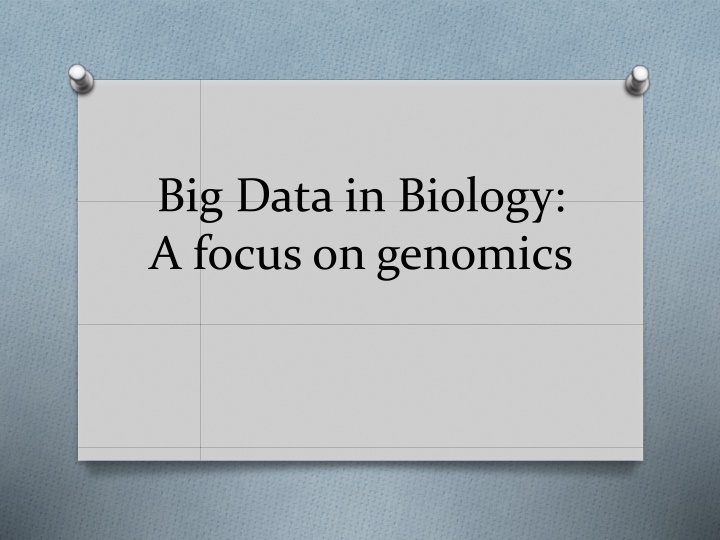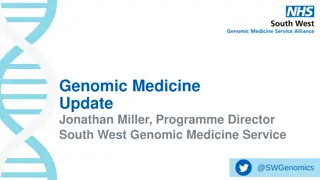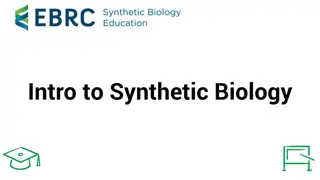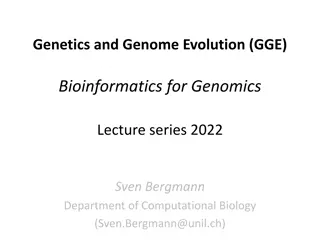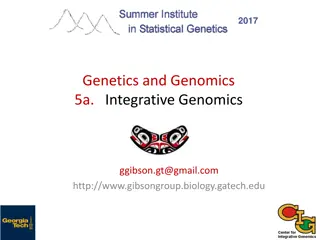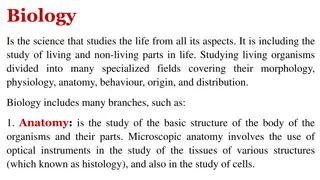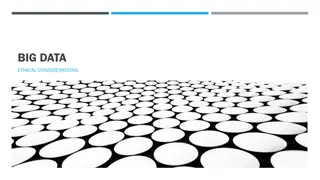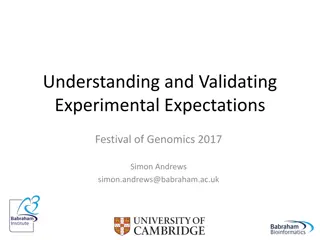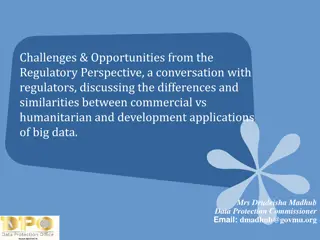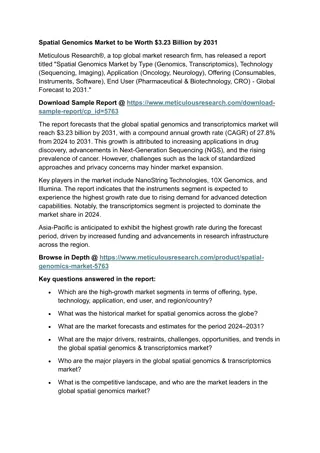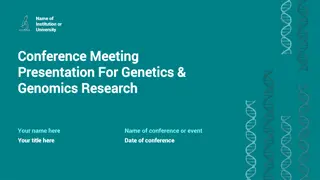Big Data in Biology: A Focus on Genomics
In the realm of genomics, big data plays a pivotal role in revolutionizing biological research. From personalized cancer medicines to biomarker discovery, the applications are vast. The exponential growth of genomic data surpasses even popular platforms like YouTube. As the field progresses, challenges in understanding genetic variations and their impact on health are being addressed. Projects like the Iceland deCODE Project are illuminating genetic risk factors for diseases like Alzheimer's and breast cancer, paving the way for personalized medicine. Despite advancements, complexities in detecting structural variants and interpreting genetic diversity across populations persist. The journey of genomics continues to unravel the intricacies of DNA, exons, single nucleotide variants, and beyond, echoing the sentiment that genomics is indeed a challenging realm characterized by continuous exploration and discovery.
Download Presentation

Please find below an Image/Link to download the presentation.
The content on the website is provided AS IS for your information and personal use only. It may not be sold, licensed, or shared on other websites without obtaining consent from the author.If you encounter any issues during the download, it is possible that the publisher has removed the file from their server.
You are allowed to download the files provided on this website for personal or commercial use, subject to the condition that they are used lawfully. All files are the property of their respective owners.
The content on the website is provided AS IS for your information and personal use only. It may not be sold, licensed, or shared on other websites without obtaining consent from the author.
E N D
Presentation Transcript
Big Data in Biology: A focus on genomics
Bioinformatics and Genomics O Applications: O Personalized cancer medicines O Disease determination O Pathway Analysis O Biomarker Discovery
An Interesting Point O One article estimated that the output from genomics may soon dwarf data heavyweights such as YouTube O I don't know if a million genomes is the right number, but clearly we need more than we've got, says Marc Williams, director of the Geisinger Genomic Medicine Institute.
Stephens, Z. D. et al. PLoS Biol.13 13, e1002195 (2015)
Genomics in the Past O DNA can have 4 different bases, A, C, G, T O Exons (1%): parts of the DNA that code for proteins O Look at nucleotides O ~13,000 single nucleotide variants. O Roughly 2% of these will affect protein composition O Unfortunately, research used cell cultures or animal modes. O However: However: Many of these associations were made with low levels of evidence.
Genomics Continued O Structural Variants deletion, duplication, and translocation. O Much harder to detect than single mutations O Many genes do not code for proteins, but can still regulate protein creation, but it s still not well known the function of many of these regions. O Capturing all such variation is desirable, but not the best in the short term O Tldr Tldr; ; genomics is hard.
Applications O Iceland deCODE Project: medical history records and genome data of 150,000 people O Led to Discovery of: O Genetic risk factors O Breast cancer O Alzheimer s O Also found 10,000 people missing 1,500 different copies of both genes. O Drug responsiveness: ADHD medicine only works for one of ten preschoolers, cancer drugs are effective for 25% of patients, and depression drugs work with 6 of 10 patients. O Personalized Medicine Personalized Medicine
Issues with Bioinformatics O Icelandic work helped by a homogeneous population. O 1000 Genomes project captured some diversity, but mainly captured Caucasian populations. O Because they come from the genetic mother ship, so to speak, people of African ancestry carry a lot more genetic variants than non-Africans Variants that seem unusual in Caucasians might be common in Africans, and may not actually cause disease. - says Isaac Kohane, a bioinformatician at Harvard Medical School in Boston, Massachusetts. O Reference genome: the comparison tool that many researchers use is flawed. O 1st iteration: random donors of unidentified ethnicity. O Currently it incorporates more human genomic diversity.
Solutions O Relationships between doctors and researchers to create models between diseases and genetics. O Harvesting genomes produces up to 40 Petabytes (PB) per a year. O Computational power: The more variables you add, the more people you add, it gets harder and harder. O Silicon Valley Lure: people needed for bioinformatics need to be able to harness massive parallel computation.
Conclusion O Two Main Issues: O Difficulty of bioinformatics due to genomics O Computational power and the need for collaboration O Yet solving these problems, could easily lead to incredible improvements in medicine.
